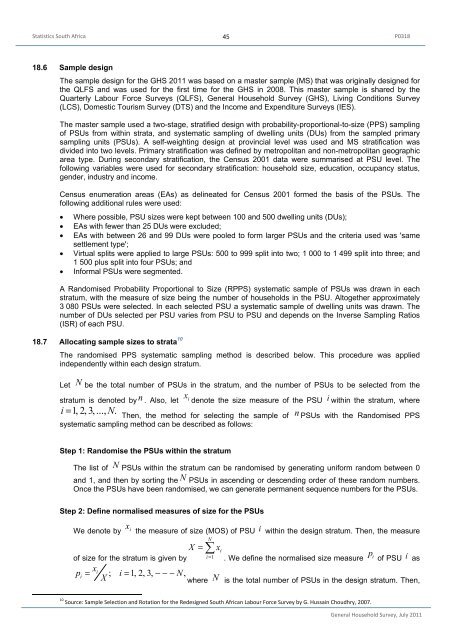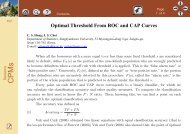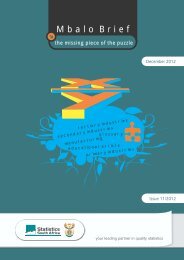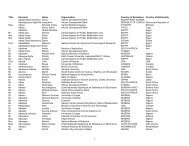General household survey - Statistics South Africa
General household survey - Statistics South Africa
General household survey - Statistics South Africa
You also want an ePaper? Increase the reach of your titles
YUMPU automatically turns print PDFs into web optimized ePapers that Google loves.
<strong>Statistics</strong> <strong>South</strong> <strong>Africa</strong> 45<br />
P0318<br />
18.6 Sample design<br />
The sample design for the GHS 2011 was based on a master sample (MS) that was originally designed for<br />
the QLFS and was used for the first time for the GHS in 2008. This master sample is shared by the<br />
Quarterly Labour Force Surveys (QLFS), <strong>General</strong> Household Survey (GHS), Living Conditions Survey<br />
(LCS), Domestic Tourism Survey (DTS) and the Income and Expenditure Surveys (IES).<br />
The master sample used a two-stage, stratified design with probability-proportional-to-size (PPS) sampling<br />
of PSUs from within strata, and systematic sampling of dwelling units (DUs) from the sampled primary<br />
sampling units (PSUs). A self-weighting design at provincial level was used and MS stratification was<br />
divided into two levels. Primary stratification was defined by metropolitan and non-metropolitan geographic<br />
area type. During secondary stratification, the Census 2001 data were summarised at PSU level. The<br />
following variables were used for secondary stratification: <strong>household</strong> size, education, occupancy status,<br />
gender, industry and income.<br />
Census enumeration areas (EAs) as delineated for Census 2001 formed the basis of the PSUs. The<br />
following additional rules were used:<br />
• Where possible, PSU sizes were kept between 100 and 500 dwelling units (DUs);<br />
• EAs with fewer than 25 DUs were excluded;<br />
• EAs with between 26 and 99 DUs were pooled to form larger PSUs and the criteria used was 'same<br />
settlement type';<br />
• Virtual splits were applied to large PSUs: 500 to 999 split into two; 1 000 to 1 499 split into three; and<br />
1 500 plus split into four PSUs; and<br />
• Informal PSUs were segmented.<br />
A Randomised Probability Proportional to Size (RPPS) systematic sample of PSUs was drawn in each<br />
stratum, with the measure of size being the number of <strong>household</strong>s in the PSU. Altogether approximately<br />
3 080 PSUs were selected. In each selected PSU a systematic sample of dwelling units was drawn. The<br />
number of DUs selected per PSU varies from PSU to PSU and depends on the Inverse Sampling Ratios<br />
(ISR) of each PSU.<br />
18.7 Allocating sample sizes to strata 10<br />
The randomised PPS systematic sampling method is described below. This procedure was applied<br />
independently within each design stratum.<br />
Let N be the total number of PSUs in the stratum, and the number of PSUs to be selected from the<br />
stratum is denoted by n . Also, let i x<br />
denote the size measure of the PSU i within the stratum, where<br />
i = 1, 2,<br />
3,<br />
..., N.<br />
Then, the method for selecting the sample of n PSUs with the Randomised PPS<br />
systematic sampling method can be described as follows:<br />
Step 1: Randomise the PSUs within the stratum<br />
The list of N PSUs within the stratum can be randomised by generating uniform random between 0<br />
and 1, and then by sorting the N PSUs in ascending or descending order of these random numbers.<br />
Once the PSUs have been randomised, we can generate permanent sequence numbers for the PSUs.<br />
Step 2: Define normalised measures of size for the PSUs<br />
We denote by i x the measure of size (MOS) of PSU i within the design stratum. Then, the measure<br />
N<br />
∑<br />
=<br />
X =<br />
of size for the stratum is given by i<br />
xi<br />
1 p<br />
. We define the normalised size measure i of PSU i as<br />
x<br />
p i<br />
i = ;<br />
X<br />
i = 1,<br />
2,<br />
3,<br />
− − − N,<br />
where N is the total number of PSUs in the design stratum. Then,<br />
10 Source: Sample Selection and Rotation for the Redesigned <strong>South</strong> <strong>Africa</strong>n Labour Force Survey by G. Hussain Choudhry, 2007.<br />
<strong>General</strong> Household Survey, July 2011















